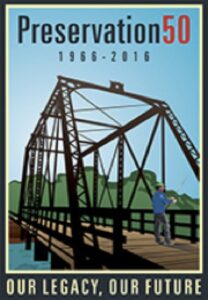[Above: Historic balconies of the New Orleans French Quarter survive modern development pressures. Photo: Jonathan Tourtellot]
So It’s Time to Herald It: The Preservation Act
Picture what the French Quarter of New Orleans would be like with an expressway slashing along the banks of the Mississippi right next to it. Imagine the impact on this popular tourist destination. Yet that’s what some Louisiana state and city planners proposed in the 1940s. The idea of a Riverview Expressway next to the Quarter remained a contentious topic for many years, a direct threat to some of the city’s iconic buildings and its most famous neighborhood.
It didn’t happen, in large part thanks to the National Historic Preservation Act (NHPA), which marks its 50th anniversary next year. Drafted with the help of the National Park Service and the National Trust for Historic Preservation, and signed by President Lyndon Johnson on October 15, 1966, the Act created the National Register for Historic Places, established State Historic Preservation Offices, the Advisory Council on Historic Preservation (ACHP), Section 106 reviews, and more.

The Act’s Section 106 process, which requires that Federal funding of a project initiate consultation with “interested parties,” gave Riverfront Expressway opponents a platform to stop plans for constructing the highway. The ACHP investigated and recommended against it. In the late 1960’s, the Federal Department of Transportation subsequently reversed funding approval for the road, and the proposal died.
Over the past 49 years, the Act has enabled revitalization and transformation of communities from coast to coast by establishing the legal framework and incentives to preserve historic buildings, landscapes, and archaeological sites, most often generating benefits for and from tourism. Focused on 2016, the Preservation50 program is the United States’ collaborative four-year effort to celebrate and leverage the NHPA’s first five decades and to assure a vibrant future for historic preservation in America.
Take the Mount Vernon Historic District of Baltimore, Maryland for example. Comprising 40 blocks in the center of the city, the district was originally a trendy, desirable, architecturally diverse neighborhood. By the 1960s, though, it was at risk of urban decay or demolition.

 Added to the National Register of Historic Places in 1971 and with many of its historic buildings now repurposed, Mount Vernon has found new life as a Baltimore cultural center. Visitors can easily reach the neighborhood by public transportation and tour the Walter’s Art Museum, one of the city’s best-known attractions, as well as various galleries and one of the earliest monuments to George Washington.
Added to the National Register of Historic Places in 1971 and with many of its historic buildings now repurposed, Mount Vernon has found new life as a Baltimore cultural center. Visitors can easily reach the neighborhood by public transportation and tour the Walter’s Art Museum, one of the city’s best-known attractions, as well as various galleries and one of the earliest monuments to George Washington.
U.S. overseas territories as well have reaped benefits from the Act. In Puerto Rico, home to a number of Spanish forts dating from the 16th century, many of the buildings making up the San Juan National Historic Site—inscribed as a World Heritage Site in 1983—had been compromised by natural disasters and poor reconstruction efforts. Based on a National Park Service plan, the sites went through a Section 106 review, and now the preservation techniques being used on the walls are held up as a worldwide model for using modern technologies to preserve historic resources. Restoration of the historic forts ensures that the sites will continue to bring tourists to Puerto Rico well into the future.
As 2016 approaches, history lovers are gearing up for a slate of programs and initiatives including contests, roundtable discussions, commemorative events, and more, all aimed at revealing the value that historic preservation delivers to the American people.
Join the Preservation50 Celebration!
Since 1966, the NHPA has generated widespread social and economic impacts. It stabilizes neighborhoods and downtowns, contributes to public education, attracts investment, creates jobs, generates tax revenues, supports small business and affordable housing, and powers America’s lucrative heritage tourism industry. Under the Act, publicly owned historic properties from community landmarks to national parks support community pride and identity, foster a variety of public uses, and contribute to local and regional economies through their operation and maintenance.
Now Preservation50 is gearing up to engage the public with a vibrant agenda of programs in 2016 to celebrate the Act’s 50th anniversary, from public events to children’s coloring books to a Leadership Development Platform. The goal is to grow a community that will lead preservation in the next 50 years.
Please join us! Become a Working Group volunteer, donate, plan a local anniversary celebration, and engage with us on social media. Visit www.preservation50.org and connect on Facebook, Twitter and Instagram.


